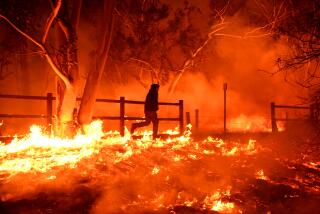Southern California Edison considers power shut-offs ahead of high winds
Thousands of Californians could once again be without power in the coming days as Southern California Edison mulls shutting off electricity to customers in an attempt to avoid wildfires sparked by windblown power lines.
Roughly 32,500 customers in six counties, including Inyo, Mono, Kern, Los Angeles, Riverside and San Bernardino, could lose power as early as Thursday as wind picks up across the inland portion of the state, said Robert Villegas, an SCE spokesman.
“We provide as much advance notice as we can ahead of when we think the weather might come,” he said. “It’s a situation that might develop, but it might not, so we ask for customers’ patience.”
Inland regions are expected to see a rapid onset of westerly winds of 10 to 15 mph on Thursday with gusts up to 30 mph that could last through Friday, according to the National Weather Service.
High winds paired with relatively low humidity can turn a fuel into a raging inferno, heightening concerns from utility companies whose power equipment has been linked to some of the state’s most devastating wildfires.
Similar conditions helped fuel the devastating Saddleridge fire that scorched nearly 8,400 acres in the hills of the northern San Fernando Valley, destroying 19 structures and damaging 88, according to most recent estimates from the Los Angeles Fire Department.
News of another round of power shut-offs comes as SCE faces growing scrutiny over possible links between the company’s electrical system and the start of the Saddleridge fire in Sylmar.
Edison’s electrical system was “impacted” around the time that investigators suspect the Saddleridge fire ignited beneath a high-voltage transmission tower, according to the utility. The cause of the fire, which is 46% contained, has not been determined.
Equipment malfunctions have been tied to some of the state’s most destructive and deadliest fires, including last year’s Camp fire — which devastated the town of Paradise in Northern California and killed 85 people — and the 2017 wine country blazes.
Investigators determined last year that Edison power lines ignited the 2017 Thomas fire, a massive blaze in Ventura and Santa Barbara counties that killed two people. Officials are still trying to determine whether power lines sparked November’s Woolsey fire, which ripped through Ventura County and Malibu.
Concerns over fire hazards prompted Pacific Gas & Electric to shut off power to large swaths of Northern California last week. Edison also cut power to roughly 24,000 customers in a few selected areas, affecting far fewer people than PG&E’s outages.
The move by both utilities stoked an already growing debate about power companies cutting electricity to prevent fires. Last week’s outages angered some customers who said that the sudden shut-offs created a whole new set of hazards by preventing people from getting news about the fires. There was also concern about those with health issues who rely on electrically powered medical equipment to stay alive.
On Monday, utility regulators ordered PG&E to take immediate corrective actions, and Gov. Gavin Newsom called on the utility to give residential customers who lost power $100 rebates.
However, PG&E contends it made the right decision to shut off electricity. The company reported more than 100 incidents of damage to their equipment during last week’s windy weather. The damage and hazards they found “represented potential sources of wildfire ignition,” according to the company.
The latest threat of shut-offs would have the largest impact on Riverside County near Cabazon and Banning, and Mono County in the Mammoth Lakes area. Roughly 12,000 customers in both counties could potentially lose power, Villegas said.
Roughly 1,500 customers in Los Angeles County, 5,600 customers in San Bernardino County, more than 500 in Inyo County and nearly 800 in Kern County could also lose electricity in the coming days.
After the wind subsides, Edison employees inspect power lines in the affected areas before they are reenergized. That process could take several days in some areas if the equipment sustains damage, Villegas said.
“Obviously we want to impact the fewest number of people possible while still getting the safety benefit of the shut-offs,” he said.
More to Read
Start your day right
Sign up for Essential California for news, features and recommendations from the L.A. Times and beyond in your inbox six days a week.
You may occasionally receive promotional content from the Los Angeles Times.







